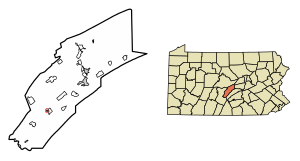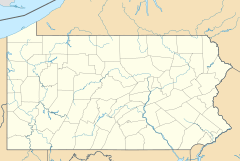McVeytown, Pennsylvania facts for kids
Quick facts for kids
McVeytown, Pennsylvania
|
|
|---|---|
|
Borough
|
|

Post office
|
|

Location of McVeytown in Mifflin County, Pennsylvania.
|
|
| Country | United States |
| State | Pennsylvania |
| County | Mifflin |
| Settled | 1762 |
| Laid out | 1795 |
| Incorporated | 1833 |
| Government | |
| • Type | Borough Council |
| Area | |
| • Total | 0.11 sq mi (0.28 km2) |
| • Land | 0.10 sq mi (0.25 km2) |
| • Water | 0.01 sq mi (0.03 km2) |
| Population
(2020)
|
|
| • Total | 344 |
| • Density | 3,621.05/sq mi (1,391.46/km2) |
| Time zone | UTC-5 (Eastern (EST)) |
| • Summer (DST) | UTC-4 (EDT) |
| Zip code |
17051
|
| Area code(s) | 717 |
| FIPS code | 42-46400 |
| Website | McVeytown |
| Local phone exchange: 899 | |
McVeytown is a small town, called a borough, located in Mifflin County, Pennsylvania, United States. It sits on the west side of the Juniata River.
This town was first settled in 1762. It was planned out in 1795 and officially became a borough in 1833. In 2020, about 344 people lived there. McVeytown was once known as Waynesburg.
A famous person named Dr. Joseph Rothrock was born in McVeytown on April 9, 1839. He is known as the "Father of Pennsylvania Forestry." He played a big role in getting land for Pennsylvania state parks and forests, like Rothrock State Forest.
Contents
History of McVeytown
The area where McVeytown is today was first settled by Samuel Holliday in 1755. He moved there permanently in 1762. The town, which was then called Waynesburg, was officially planned out in 1795. John McVey owned the land and is considered the founder of McVeytown.
Early Settlers and Land
Samuel Holliday and Andrew Bratton were among the early settlers. In 1775, they went looking for land to settle after a big land purchase from Native Americans. They chose their land and got official documents for it in Philadelphia. Bratton settled in what is now Bratton Township. Holliday settled in the area that became McVeytown.
Geography of McVeytown
McVeytown is located at 40°29′51″N 77°44′27″W / 40.49750°N 77.74083°W. It is a small area.
Across the Juniata River, on its east side, is a small community called Mattawana Village. The borough covers about 0.1 square miles (0.28 square kilometers). Most of this area is land, and a small part is water.
Population and People
| Historical population | |||
|---|---|---|---|
| Census | Pop. | %± | |
| 1840 | 348 | — | |
| 1850 | 580 | 66.7% | |
| 1860 | 541 | −6.7% | |
| 1870 | 685 | 26.6% | |
| 1880 | 679 | −0.9% | |
| 1890 | 599 | −11.8% | |
| 1900 | 520 | −13.2% | |
| 1910 | 514 | −1.2% | |
| 1920 | 480 | −6.6% | |
| 1930 | 566 | 17.9% | |
| 1940 | 581 | 2.7% | |
| 1950 | 546 | −6.0% | |
| 1960 | 488 | −10.6% | |
| 1970 | 486 | −0.4% | |
| 1980 | 447 | −8.0% | |
| 1990 | 408 | −8.7% | |
| 2000 | 405 | −0.7% | |
| 2010 | 342 | −15.6% | |
| 2020 | 344 | 0.6% | |
| 2021 (est.) | 342 | 0.0% | |
| Sources: | |||
In 2000, there were 305 people living in McVeytown. These people lived in 168 households, and 115 of these were families.
About 29% of the households had children under 18 living with them. Many households, about 53%, were married couples living together. The average household had about 2.4 people.
The population included people of different ages. About 21% were under 18 years old. About 25% were 65 years or older. The average age in McVeytown was 41 years old.
Images for kids
See also
 In Spanish: McVeytown para niños
In Spanish: McVeytown para niños






